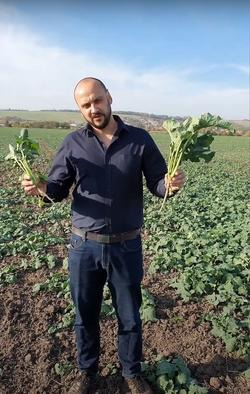As Farm to Fork regulations take hold, farmers need in-crop solutions
Changes are coming to farmers in Europe—whether they like it or not. With Europe’s Green Deal and Farm to Fork strategy, agricultural practices are under scrutiny and changes to farming practices are imminent.
Here’s a quick look at changes coming down the pike:
- Reduce pesticide use by 50%
- Drop fertilizer use by 20% to achieve 50% less nutrient loss
- Boost organic production to 25% of all agricultural land
- Take 10% of land currently farmed out of production
All of this is coming and putting pressure on yields, despite increasing populations and demand. To put it simply, farmers need new solutions.
Why Farmers Need Innovation
Regardless of policy, pests and diseases will reoccur every year in varying levels of severity. For farmers, not having access to effective pesticides could mean crops are destroyed by these persistent pests if other resistances or defenses are not created.
“As breeders our job is to provide additional value to farmers with new genotypes,” says Artur Kozera, product manager at RAPOOL-RING in Poland. “In times of new restrictions of insecticides and other pesticides and the high cost of nitrogen fertilizers, they need genetics that can help.”
If you look at the advancements breeders have made over the past few decades, it’s easy to see how vast the opportunities are for yield growth. This comes from more accurate selections during trials but also from understanding what it takes to achieve high yields.
“Everyone has different challenges,” says Pavel Jezek, product developer at RAPOOL-RING in Czech Republic. “Drought and pressure of flea beetles (Phyllotreta and Psylliodes), aphids and cabbage root fly—these are the types of issues pulling down yield already at the beginning.”
Yield is a result of three factors: management, genetics and environment. You control the management; Mother Nature controls the environment and RAPOOL-RING looks to take what control over genetics breeders can to maximize their potential and to work well with the other factors.
Solutions for Incessant Pest Pressures
Farmers battling flea beetle only have access to two seed treatment products for control, and neither are totally effective. Also the options of pest control by spraying are limited. As pest pressures continue, this limited access to control methods will only be squeezed tighter with ongoing regulations.
Imagine a future where a beetle biting into a plant and ingesting a naturally occurring bacteria or protein kills the insect. Or picture an oilseed rape variety that is tolerant to critical diseases and survives when neighboring fields cripple under the disease. Also think about what it would mean for over wintering crops such as oilseed rape to be more winter hardy. These are products and potential futures that can be found through breeding.
“We’re offering solutions,” Kozera says. “There are new kinds of resistances, for example, against viruses and diseases.”Technologies such as there are available in many countries in a GMO-form, but breeders in Europe are looking for natural defenses against pests so the product won’t be labeled ‘GMO.’ RAPOOL-RING is actively researching and commercializing conventionally bred varieties to address insect, virus, and disease pressure.
Using traditional breeding methods increases the likelihood of product approval and the ease at which farmers can sell the grain at the end of the season. In addition, extensive testing means the products will not only show efficacy against target pests but showcase yield advantages. To gain approval in the EU requires products to show superiority over previously available products.
“We always look for products that are adaptable and continuously look for new solutions for not only today, but generations in the future,” Jezek says. “The future is using breeding to get us closer to nature.”
Look for a not-too-distant future of crops that withstand not only weather challenges through genetics, but key pests, too. In a world of reduced pesticides, it’s a critical method to help the food system meet population demands.



